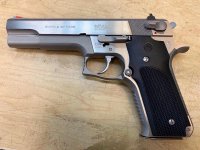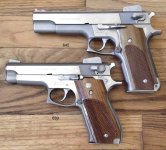You are using an out of date browser. It may not display this or other websites correctly.
You should upgrade or use an alternative browser.
You should upgrade or use an alternative browser.
Model 645 Serial range.first production.
- Thread starter RON K.
- Start date
Anybody know when they started.i know 1985 through 1988.
OK I'll finally play.
I've got a TBN prefix example that I kinda modded years ago. More relevant to the original question, (from 2013,) I found some info. I thought I remembered this 645 reference but could not remember where it was in regards to Letters.
I Lettered my immaculate with everything 4505 w/4567 top end hoping it was factory. Nope. Luckily JP=PPCSHOOTER could explain how it got that way.
***Edit To Add*** Roy was going by written records so sometimes the dates are obviously out of sequence and or wrong. Prototype after production dates can't be correct.
Jim
Attachments
Last edited:
Frank Black
Member
That's an obvious typo on Jenk's part. He meant August of 1985 for the M645 prototypes, not August of 1988 when the series ended.OK I'll finally play.
I've got a TBN prefix example that I kinda modded years ago. More relevant to the original question, (from 2013,) I found some info. I thought I remembered this 645 reference but could not remember where it was in regards to Letters.
I Lettered my immaculate with everything 4505 w/4567 top end hoping it was factory. Nope. Luckily JP=PPCSHOOTER could explain how it got that way.
***Edit To Add*** Roy was going by written records so sometimes the dates are obviously out of sequence and or wrong. Prototype after production dates can't be correct
That's an obvious typo on Jenk's part.
That's an obvious typo on on your part. His name is Jinks, not Jenks.
I just bought a Model 645 from the estate of a Smith & Wesson Range Employee. He was a Test Shooter. The serial number is TBT0000. I haven't gotten it yet.
Frank Black
Member
Pretty sure it's 'Jinx.' ….That's an obvious typo on Jenk's part.
That's an obvious typo on on your part. His name is Jinks, not Jenks
Frank Black
Member
Pics please, ….. or it didn't happen.I just bought a Model 645 from the estate of a Smith & Wesson Range Employee. He was a Test Shooter. The serial number is TBT0000. I haven't gotten it yet.
Yendor357
Member
Maybe the following is common knowledge, but it was a learning experience for me.
I was talking to my Gunsmith today about all sorts of stuff. He is very knowledgeable. I said something to the effect of how I struggle to get decent accuracy from my 645,745, 4506, and 4566 with cast bullet reloads.
He said those guns were designed as Law Enforcement weapons. They were designed to shoot 185-200 grain JHPs. Even back then in the 80s, Law Enforcement was aware of over penetration.
I told him my S&W 45s shoot really well with said 185-200 JHPs. Cast, not so much. That may also shed some light on why the G3 Smiths had a reputation for being Combat Accurate. Maybe guys weren't having any better luck than I with cast bullets, and simply blamed the guns.
I was talking to my Gunsmith today about all sorts of stuff. He is very knowledgeable. I said something to the effect of how I struggle to get decent accuracy from my 645,745, 4506, and 4566 with cast bullet reloads.
He said those guns were designed as Law Enforcement weapons. They were designed to shoot 185-200 grain JHPs. Even back then in the 80s, Law Enforcement was aware of over penetration.
I told him my S&W 45s shoot really well with said 185-200 JHPs. Cast, not so much. That may also shed some light on why the G3 Smiths had a reputation for being Combat Accurate. Maybe guys weren't having any better luck than I with cast bullets, and simply blamed the guns.
Looking at one of my Model 645's, the rifling twist rate appears to be 1 turn in 16 inches and the rifling is shallow. This matches the specifications used by Colt in the development of the 45 ACP cartridge and their pistols chambered in 45 ACP.Maybe the following is common knowledge, but it was a learning experience for me.
I was talking to my Gunsmith today about all sorts of stuff. He is very knowledgeable. I said something to the effect of how I struggle to get decent accuracy from my 645,745, 4506, and 4566 with cast bullet reloads.
He said those guns were designed as Law Enforcement weapons. They were designed to shoot 185-200 grain JHPs. Even back then in the 80s, Law Enforcement was aware of over penetration.
I told him my S&W 45s shoot really well with said 185-200 JHPs. Cast, not so much. That may also shed some light on why the G3 Smiths had a reputation for being Combat Accurate. Maybe guys weren't having any better luck than I with cast bullets, and simply blamed the guns.
The 45 ACP cartridge was originally designed using a jacketed 200 grain bullet at 900 fps. The final version of the cartridge design increased the bullet weight to 230 grains and the velocity was to be 850 fps, giving the final version more energy at the muzzle and retained energy downrange, but no change was made to the specified rifling twist rate.
Generally speaking, twist rate vs bullet weight has far less impact on accuracy in handguns than it does in rifles. The depth of the rifling and smoothness of the bore can affect accuracy with lead bullets. Shallow rifling works well with jacketed bullets, but cast lead bullets usually perform better with deeper rifling. That being said, excellent accuracy can be obtained with lead bullets and shallow rifling, but it can take experimentation with powders, velocity, and bullet hardness.
Last edited:
Frank Black
Member
I'll have to test that theory with my 645 and 4506 shooting my 'standardized' .45 handload. I thought I had already done that but don't see anything noted in the range notes I keep with these two guns.Looking at one of my Model 645's, the rifling twist rate appears to be 1 turn in 16 inches and the rifling is shallow. This matches the specifications used by Colt in the development of the 45 ACP cartridge and their pistols chambered in 45 ACP.
The 45 ACP cartridge was originally designed using a jacketed 200 grain bullet at 900 fps. The final version of the cartridge design increased the bullet weight to 230 grains and the velocity was to be 850 fps, giving the final version more energy at the muzzle and retained energy downrange, but no change was made to the specified rifling twist rate.
Generally speaking, twist rate vs bullet weight has far less impact on accuracy in handguns than it does in rifles. The depth of the rifling and smoothness of the bore can affect accuracy with lead bullets. Shallow rifling works well with jacketed bullets, but cast lead bullets usually perform better with deeper rifling. That being said, excellent accuracy can be obtained with lead bullets and shallow rifling, but it can take experimentation with powders, velocity, and bullet hardness.
That load is a coated 230grn hardcast bullet (H&G #34 boolit - pic attached) seated over 4.7- 4.8 grns of Bulleyes. So, roughly, replicating Mil 230grn ball ammo. It has shot very well from 50-feet in all my 1911s.
Attachments
Nice to see there is still a want and a desire to learn almost 13 years later on these. And thru my own expertise with guns. Over 50 years. i always figured its the owner and shooter not the gun..the 645 came around at a time people wanted something different in 45acp....Smith delivered. not sure they could produce a 40th ann. edition today.
but i enjoy what we have from that past.RON K.
but i enjoy what we have from that past.RON K.
Similar threads
- Replies
- 0
- Views
- 593
- Replies
- 15
- Views
- 2K
- Replies
- 58
- Views
- 5K
- Replies
- 21
- Views
- 2K




